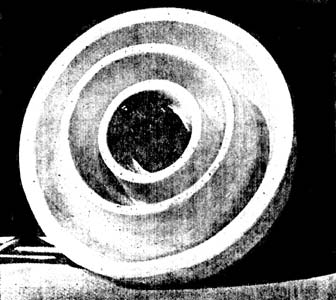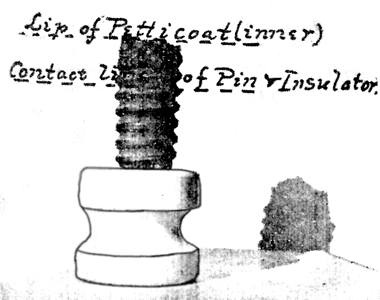[Trade Journal]
Publication: The Journal of Electricity
San Francisco, CA, United States
vol. 5, no. 3, p. 56-57, col. 1-2
THE BURNING OF INSULATOR PINS.
BY W. STUART-SMITH.
Experience with high-tension lines in California has developed the fact that with voltages of 10,000 and over, the production of insulators that will not be punctured under the static strain, or that will not allow the current to soak through the body, is not the only requisite to maintenance of line. With potentials up to, and somewhat exceeding 5,000 volts, the protection of a sufficiently resisting insulator was all that was requisite, but when potentials of 10,000 volts had been in use for a year, it was found that during the storms of the second winter the pins began to give way and during storms of several days duration, it is no uncommon thing to replace from half a dozen to a dozen pins. Destruction occurs in a variety of ways, but the most common is for the pin to burn off just abreast the lip of the inner petticoat, as shown in the illustration herewith.
| |||
| A View of A Burned-Off Pin. |
Discussion with the operating engineers of plants has developed the fact that this burning is generally considered to be due to heavy leakage over the surface of the insulator and wet pin, the idea being that the volume is sufficiently great to heat the pin to the charring point. If this was the case the pins would be generally found charred throughout the body, with maximum burn near the line of contact of insulator and pin and extending somewhat into the threaded portion of the insulator. As a matter of fact, the burn is generally confined to a very short length just under the lip of the inner petticoat, the lower portion of the pin and the portion screwed into the insulator being intact; also where the inner petticoat has considerable depth the pin shows no sign of burn for a distance of from one-fourth to one-half an inch below the contact line of pin and insulator. This proves conclusively that the current does not creep over the insulator surface to contact the pin and then down the latter, because in this case the line of contact would show the greatest burn, whereas it shows absolutely none at all.
| |||
| The Burned Pin. |
The accompanying illustrations are from photographs of the portion of such a burned-off pin left in the insulator and show clearly the clean burn-off abreast the lip of the petticoat and also the fact that the portion of the pin in the insulator and for some distance below the contact line of pin (also shown) and insulator is absolutely free from burn.
A little consideration will show that the burning is probably due to sparks passing horizontally between the pin and the lower edge of the inner petticoat. It seems probably that the electricity accumulates on the edge of the petticoat, the potential increasing until the strain becomes so great that the dielectric is pierced and a spark passes between the edge of the petticoat and the pin. Owing to the pin presenting a flat surface and the edge of the insulator being rounded, a very considerable quantity will pass at each discharge, and the burning power will be comparatively great. The manner in which these burnoffs occur is difficult to explain, except as above.
It is possible that the electricity reaches the edge of the inner petticoat by jumping from one petticoat edge to another, the path through the air being filled with spray perhaps offering less resistance than the long surfaces over the petticoats.
Pins burned in this manner are never seen on lines with a potential of 5000 volts; they are comparatively frequent on 10,000 volt lines and with potentials much in excess of this the passing of sparks and consequent burning will be so great as to render the use of plain wooden pins impossible.
It is probably that the use of some such device as the porcelain sleeve on the lower portion of the pin, introduced by Mr. Fred M. Locke, will prove effective, owing to the sparking taking place between incombustible surfaces. It is also possible that plain wooden pins could be used if a narrow metal band was placed around it just below the edge of the petticoat lip, said band being provided with two or three points extending towards the lip and taking the discharge. The quantity of electricity passing with each spark would be smaller than when the discharge passes between blunt surfaces and the burning power would be small, also the surfaces between which it passes would be incombustible.


